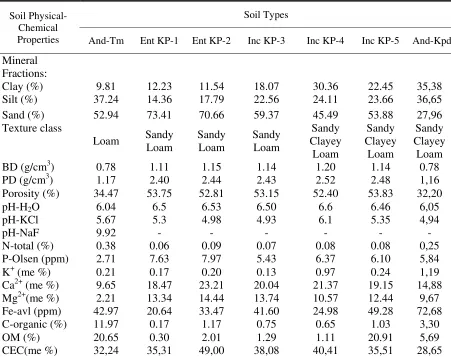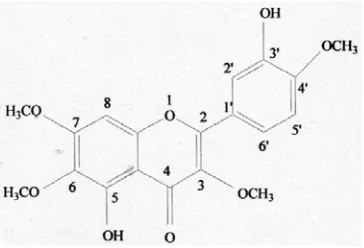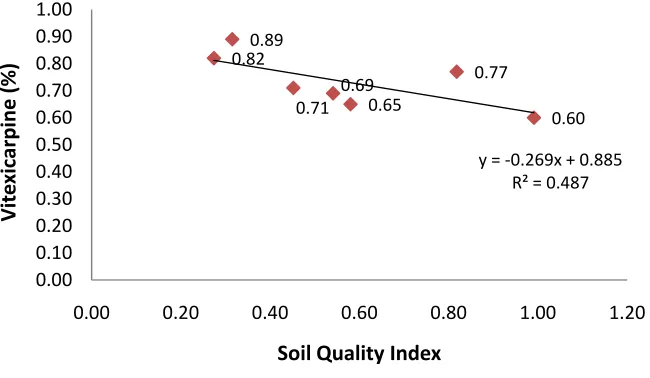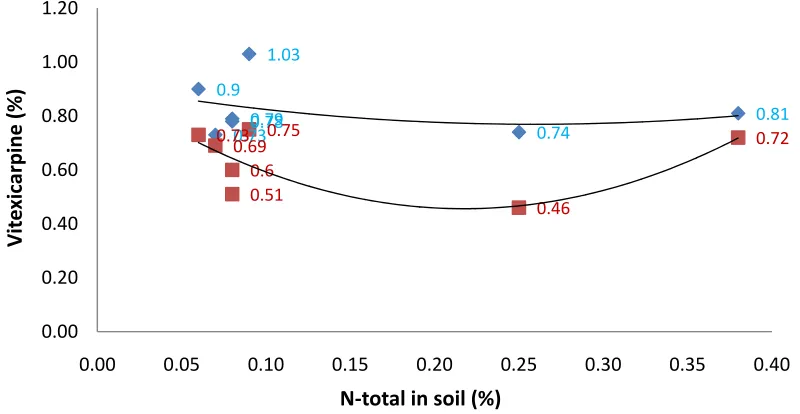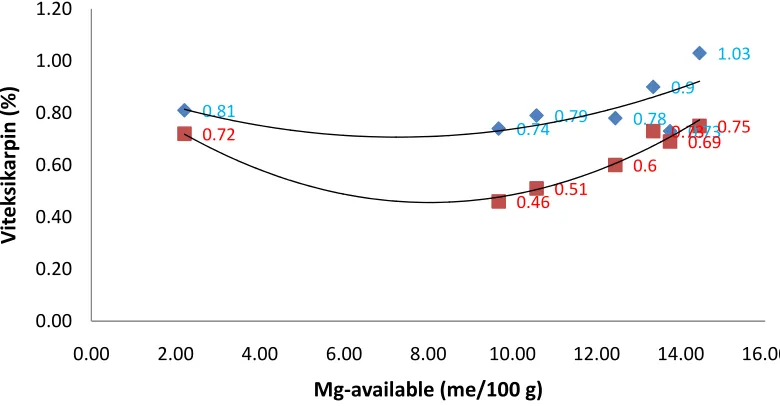RELATIONSHIP OF SOIL QUALITY AND VITEXICARPINE CONTENT IN THE LEAVES OF VITEX TRIFOLIA L1
Eko Hanudin1), Yosi Bayu murti2), Mifhadi Setiawan3), Zullies Ikawati4), Nunung Yuniarti5)
Laboratory of 1&3Soil Chemistry and Fertility, Department of Soil Sciences, Faculty of Agriculture, Laboratory of 2Pharmaceutical Biology, 4&5 Laboratory of Pharmacology and Toxicology, Faculty of
Pharmacy, UGM Yogyakarta, Indonesia. Corresponding Author: [email protected] or [email protected]
Abstract
Vitex trifolia L is one of thousands medical plants growed in Indonesia. Until now, information about the marker compound in the medical plant is still scarce. Some Indonesian traditional therapist believe that the leaves of Vitex trifolia L could be used as medicine for antiasthma, antialergy and anticancer. Vitexicarpine has been known as a marker compound observed in the leaves of Vitex trifolia L. An explorative research was conducted to find out relationship of soil quality and vitexicarpine content in the leaves of Vitex trifolia L. The plant was found in the some districts in Central Java (Surakarta) and Yogyakarta (Kulon Progo). Soil types where the plant growed are Entisols, Inceptisols and Andisols. Soil physical and chemical analyses was conducted for soil effective deep, texture, porosity, bulk density, pH, C-org, N-tot, P-available, K-available, Ca-available and Mg-available. Minimum data set (MDS) method was applied for calculating the soil quality index. Vitexicarpine content in the leaves was determined by Thin Layer Chromatography method. The results indicated that soil quality index and vitexicarpine content in the leaves of Vitex trifolia L has a negative correlation. Lower the soil quality tend to result in higher content of vitexicarpine. Soil quality index of Andisols from Karangpandan-Surakarta is 0.991 and vitexicarpine content in the leaves is only 0.6 %, but in case of Entisols is 0.274 and vitexicarpine content be able reach around 0.82 %. Inceptisols quality index was an intermediate between Andisols and Entisols. However, individually nutrient indicated a positive correlation with vitexicarpine content. Higher content in Nitrogen and Magnesium in the soil, higher content in vitexicarpine in the leaves. This may related to the role of the both nutrient in biosynthesis of vitexicarpine.
Key words: soil quality index, Vitex trifolia L, vitexicarpine
Introduction
Vitex trifolia L is one of thousands medical plants growed in Indonesia. The plant known
as an annual plant which has many beneficial. Until now, information about the marker
compound in the medical plant is still scarce. Some Indonesian traditional therapist believe
that the leaves of Vitex trifolia L could be used as a medicine for antiasthma, antialergy and
anticancer. The leaves contain a volatil oil composed of sesquiterpen, terpenoide, ester
compound, alcaloid (vitrisin), glycoside flavon (artemetin and 7-desmetil artemetin) and non
flavonoid friedelin components, ß-cytosterol, glucose and hydrocarbon compound which has
analgesic and anti allergy. Vitexicarpin is known as a pharmacologic active component in the
leaves of Vitex trifolia L and suitable as a marker compound (Alam et al., 2002; Ikawati et
al., 2001). One step in obtaining extract with a high consistency in the active compound
concentration should be observed through a selection process for a standardized raw materials
and post harvesting process (Bauer, 1998; Puspitasari et al., 2008).Therefore, Vitex trifolia L
is a prospective plant to be developed as medical plant in an industry scale. For the purpose,
the plant should be growed in a good environment and soil quality (Maheswari, 2002). The
main objective of the research is to find out relationship of soil quality index and
vitexicarpine content in the leaves of Vitex trifolia L.
Materials and Methods
This research is an explorative study conducted to find out relationship of soil quality
and vitexicarpine content in the leaves of Vitex trifolia L. The soil and plant samples were
collected from 7 locations, namely: Tawangmangu (Andisols) and Karangpandan (Andisols),
the two locations are situated in District of Surakarta (Province of Central Java) and the five
one (KP-1: Entisols, KP-2: Entisols, KP3: Inceptisols, KP-4: Inceptisols and KP-5:
Inceptisols) are situated in District of Kulon Progo (Province of Yogyakarta). Soil orders
were observed under the Vitex trifolia L stand could be classified into 3 orders, namely:
Entisols, Inceptisols and Andisols. Soil physical and chemical analyses was done for soil
effective deep, texture (sand, silt and clay fractions were determined by pipette method),
porosity (n), bulk density (wax method), pH (electrode pH-meter), C-org (Walkey and
Black), N-tot (Kjeldahl method), P-available (Olsen method), K-available, Ca-available and
Mg-available (extracted by NH4OAc and measured by AAS). Minimum data set (MDS)
method was applied for calculating the soil quality index (Karlen et al., 1996). Vitexicarpine
content in the leaves was determined by Densitometry Thin Layer Chromatography Method
(TLC Scanner 3 CAMAG).
Results and Discussion Physical and chemical properties of the soils
Physical and chemical properties of soils under stand of Vitex trifolia L are presented in
the Table 1. In general, we observed three orders of soils, namely: Andisols, Incepstisols, and
Entisols. The soil physical properties such as texture (proportion of sand, silt and clay), bulk
density, particles density and porosity were in a range of sandy clayey loam–loam, 0.78-1.2
g/cm3, 1.17-2.52 g/cm3 and 34.47-53.83 %, respectively. The soil reaction could be
C-organic (except for Andisols in a high rate) in all of the soil types were categorized as a low rate.
In case of Ca2+, Mg2+ and Fe content was categorized as medium-high rate.
Table 1. Selected physical and chemical properties of the soils studied
Soil Physical-Chemical Properties
Soil Types
And-Tm Ent KP-1 Ent KP-2 Inc KP-3 Inc KP-4 Inc KP-5 And-Kpd
Mineral Fractions:
Clay (%) 9.81 12.23 11.54 18.07 30.36 22.45 35,38
Silt (%) 37.24 14.36 17.79 22.56 24.11 23.66 36,65
Sand (%) 52.94 73.41 70.66 59.37 45.49 53.88 27,96
Texture class
Loam Sandy Loam
Sandy Loam
Sandy Loam
Sandy Clayey Loam
Sandy Clayey Loam
Sandy Clayey Loam
BD (g/cm3) 0.78 1.11 1.15 1.14 1.20 1.14 0.78
PD (g/cm3) 1.17 2.40 2.44 2.43 2.52 2.48 1,16
Porosity (%) 34.47 53.75 52.81 53.15 52.40 53.83 32,20
pH-H2O 6.04 6.5 6.53 6.50 6.6 6.46 6,05
pH-KCl 5.67 5.3 4.98 4.93 6.1 5.35 4,94
pH-NaF 9.92 - - -
N-total (%) 0.38 0.06 0.09 0.07 0.08 0.08 0,25
P-Olsen (ppm) 2.71 7.63 7.97 5.43 6.37 6.10 5,84
K+ (me %) 0.21 0.17 0.20 0.13 0.97 0.24 1,19
Ca2+ (me %) 9.65 18.47 23.21 20.04 21.37 19.15 14,88
Mg2+(me %) 2.21 13.34 14.44 13.74 10.57 12.44 9,67
Fe-avl (ppm) 42.97 20.64 33.47 41.60 24.98 49.28 72,68
C-organic (%) 11.97 0.17 1.17 0.75 0.65 1.03 3,30
OM (%) 20.65 0.30 2.01 1.29 1.11 20.91 5,69
CEC(me %) 32,24 35,31 49,00 38,08 40,41 35,51 28,65
Note: And-Tm: Andisols-Tawangmangu, Ent KP: Entisols Kulon Progo, Inc KP: Inceptisols Kulon Progo, Inc-Kpd: Inceptisols Karangpandan, BD:Bulk Density, PD:Particle Density
Vitexicarpine Content in the Leaves of Vitex trifolia L
Analysis of Vitex trifolia L leaves indicated that vitexicarpine content in the leaves was
a wide variation. It is likely to related to leaves maturation and location where the leaves
collected (presented in Figure 1). Free vitexicarpine content is higher in young leaves (0.36
-0.42 %) than older leaves (0.22-0.31 %). As levels of free forms, levels of bound forms
(nonfree) also showed similar results. Young leaves had a higher concentration (0.32 to
0.53%) than older one (0.24 - 0.42%). This result is surprising considering the higher
vitexicarpine content was found in the leaves with low maturation level.
Proportion between the vitexicarpine aglycone and vitexicarpine glycoside content
glycoside
of the Vitex tr
Figure 2. Chemical structure of vitexicarpin proposed by Alam et al. (2002)
Soil Quality Index (SQI) and Vitexicarpine Content
Soil quality is the capacity of a soil to function within ecosystem boundaries to sustain
biological productivity, maintain environmental quality, and improve the health of plants and
animals. Soil quality index is an index based on the value and weight of each indicator of soil
quality. Soil quality indicators were selected from properties that show the capacity of the
soil functions that determine the level of soil fertility. Indicators of soil quality is the nature,
characteristics or physical processes, chemical, and biological soil that can describe the
condition of the soil (Doran and Parkin, 1994; SQI, 2001). Based on the calculation of the
soil quality index of each research area are presented in Table 2.
Table 2. Soil quality index (SQI) from the area studied
Soil sample location Soil Quality Index SQI rate
KP-1 0,274 Low KP-2 0,315 Low
KP-3 0,452 Medium
KP-4 0,580 Medium
KP-5 0,541 Medium
TM 0,818 Very Good
KRP 0,991 Very Good
According to Wander et.al. (2002), based on scoring functions indicate soil quality rate
for a particular land use, determined from 0-1. Soil quality index values closer to the value
of one the better soil quality. Based on Table 2, it was known that the soil quality index of
the seven research sites could be categorized at a range of low to very good rating. Soil
samples from Kulon Progo 1 and 2 could be classified as Entisols order and have SQI values
of 0.274 and 0.315, respectively, and the both value could be categorized as a low soil
Inceptisols order and have SQI values of 0.452, 580 and 0.541, respectively, and all the three
value could be categorized as a medium soil quality rate. Soil which has a very good rate in
the soil quality is Andisols orders found in Tawangmangu and Karangpandan (0.818 and
0.991, respectively)
Table 3. Relationship of soil quality index and vitexicarpine concentration in young and old leaves of Vitex trifolia L.
Locations Soil Quality Index Vitexicarpine content (%) Average (%) Young Leaves Old Leaves
KP-1 0.274 0.90 0.73 0.82
KP-2 0.315 1.03 0.75 0.89
KP-3 0.452 0.73 0.69 0.71
KP-4 0.580 0.79 0.51 0.65
KP-5 0.541 0.78 0.60 0.69
TM 0.818 0.81 0.72 0.77
KRP 0.991 0.74 0.46 0.60
Based on the table 3, it is known that the location of study has a soil quality index and
vitexicarpine content in the leaves of V. trifolia diverse. Relationship of soil quality index
and vitexicarpine concentration in the leaves of V. trifolia has a negative correlation (Figure
3). This means that the higher the soil quality index, the vitexicarpine concentration in the
leaves of V. trifolia relatively lower. This is due to the plant has a capability for survival
through a certain metabolism mechanism in the plant cell if under a high environmental
pressure. Soil quality index of Andisols from Karangpandan-Surakarta is 0.991 and
vitexicarpine content in the leaves is only 0.6 %, but in case of Entisols is 0.274 and
vitexicarpine content be able reach around 0.82 %. Inceptisols quality index was an
intermediate between Andisols and Entisols.
In general, it has been known that soil is an important factor controlling the
vitexicarpine production in the V. trifolia. Nutrient availability in soil is needed to produce
the secondary metabolite compounds in the plant. There are several soil nutrients has an
Figure 3. Relationship between soil quality index and vitexicarpine concentration
synthesis of vitexicarpine, such as: nitrogen, magnesium, and iron. Nitrogen and magnesium
has an important role in synthesis of flavonoid compound (Torsell 1997). Nitrogen also has
an important role in synthesis of amino acid and protein in the plant (Epstein and Bloom,
2005). In the synthesis process of the secondary metabolite, the role of nitrogen as a building
material, especially for synthesis of amino acid (tyrosine and phenylalanine) through
biosynthetic pathway of shikimic acid in form of phenile propane (C6 – C3) (Winkel, 2006).
Relationship between N-total in the soil and vitexicarpine concentration in the young and
old leaves of V.trifolia L was presented at Figure 4. Based on the figure, nitrogen in the soil
has a positive correlation with vitexicarpine concentration in the leaves of V. trifolia L. It
means that the higher nitrogen concentration in the soil, the higher vitexicarpine
concentration in the leaves of plant.
It is known well that N is a mobile nutrient in the plant, so the N content in the young
leaves is higher than the older one (Epstein and Bloom, 2005). This has become one of the
causes vitexicarpine concentration in young leaves was higher than in older leaves.
Cocentration of N in Entisols and Inceptisols were observed at range of 0.06-0.09 %.
According to soil chemical analysis criteria (CSR, 2009), the range of the value could be
categorized as a very low rate, while in Andisols were observed at range of 0.25-0.38
(medium) (presented at Table 1). 0.82
0.89
0.71 0.65
0.69 0.77
0.60 y = ‐0.269x + 0.885
R² = 0.487
0.00 0.10 0.20 0.30 0.40 0.50 0.60 0.70 0.80 0.90 1.00
0.00 0.20 0.40 0.60 0.80 1.00 1.20
Vit
e
xicarp
ine
(%)
Figure 4. Relationship between N-total in the soil and vitexicarpine concentration in the young and older leaves of V.trifolia L.
Magnesium (Mg) also an important macronutrients required by plant as a nucleus of
chlorophyl molecule. The molecule has an important role in photosynthesis, synthesis of fatty
acid and oil in the plant (Epstein and Bloom, 2005). In the synthesis of secondary metabolite,
the role of Mg as a catalyst for biosynthetis pathway from malonic acetate to Acetyl CoA
(C2) and contributed in increasing the vitexicarpine in the leaves of V. trifolia L.
Combination of the both biosynthetic pathway of malonic acetate and shikimic acid resulted
in flavonoid compounds. The flavonoid compound should undergo a flavonoid
methyltransferase process with Mg2+ ion and SAM as catalyst and finally resulted in the
vitexicarpine compound (Torsell, 1997). Relationship between Mg-available in the soil and
vitexicarpine concentration in the young and older leaves of V.trifolia L was prsented at
Figure 5. Based on the figure, magnesium in the soil has a positive correlation with
vitexicarpine concentration in the leaves of V. trifolia L. It means that the higher magnesium
concentration in the soil, the higher vitexicarpine concentration in the leaves of plant.
Magnesium is a mobile nutrient in the plant, even not as mobile as nitrogen, but Mg in
the older leaves will be translocated to the young leaves. That’s why the Mg content in the
young leaves is higher than the older one (Epstein and Bloom, 2005). This may related to the
positive correlation between Mg and vitexicarpine concentration in the leaves of V. trifolia L,
and also resulted in the vitexicarpine concentration in young leaves was higher than in older
one.
Young
Old Leavess 0.9
1.03
0.730.790.78
0.81 0.74
0.73 0.75 0.69
0.51 0.6
0.72
0.46
0.00 0.20 0.40 0.60 0.80 1.00 1.20
0.00 0.05 0.10 0.15 0.20 0.25 0.30 0.35 0.40
Vit
e
xicarp
ine
(%)
Figure 5. Relationship between Mg-available in the soil and vitexicarpine concentration in the young and older leaves of V.trifolia L.
Cocentration of Mg in Andisol, Entisols and Inceptisols were observed at range of
2.21-9.67, 13.34-14.44 and 10.57-13.74 me %, respectively. According to soil chemical
analysis criteria (CSR, 2009), the range of the value could be categorized as a high-very high
rate (SRC, 2009). A high availability of Mg in the soil resulted in the Mg content in the plant
also become high, and may stimulate for formation of Clorophy, in turn the producrtion of
oil, fatty acid, and vitexicarpine also increased.
Conclusions
A negative correlation was observed for the soil quality index and vitexicarpine content
in the leaves of Vitex trifolia L. Lower the soil quality tend to result in higher content of
vitexicarpine. Soil quality index of Andisols from Karangpandan-Surakarta is 0.991 and
vitexicarpine content in the leaves is only 0.6 %, but in case of Entisols is 0.274 and
vitexicarpine content be able reach around 0.82 %. Inceptisols quality index was an
intermediate between Andisols and Entisols. However, individually nutrient indicated a
positive correlation with vitexicarpine content. Higher content in Nitrogen and Magnesium in
the soil, higher content in vitexicarpine in the leaves. This may related to the role of the both
nutrient in biosynthesis of vitexicarpine.
Acknowledgements
We would like to thank to Minister of Research and Technology (RISTEK) supported the fund for conducting this research. Also thank to LPPM-UGM facilitate RISTEK Grant competition.
Young Leavess
Older leavess
0.9 1.03
0.73
0.79 0.78
0.81
0.74 0.73 0.75
0.69
0.51
0.6 0.72
0.46
0.00 0.20 0.40 0.60 0.80 1.00 1.20
0.00 2.00 4.00 6.00 8.00 10.00 12.00 14.00 16.00
Vit
e
k
sik
arp
in
(%)
References
Alam G., Wahyuono S., Ganjar I.G., Hakim L., Timmerman H., and Verpoorte R., (2002). Tracheospasmolytic activity of viteosin-A and vitexicarpin isolated from Vitex trifolia L. Planta Med 68:1047-1049.
Bauer R., (1998). Quality criteria and standardization of phytopharmaceuticals: can acceptable drug standards be achieved? Drug Information Journal 32:101-110.
Doran, JW. and Parkin, T.B. 1994. Defining and Assessing Soil Quality, In Defining Soil Quality for a Sustainable Environment. JW. Doran, DC. Coleman, DF. Bezdicek, & BA. Stewart (eds). SSSA Spec. Pub. No. 35. Soil Sci. Soc. Am., Am. Soc. Agron., Madison, WI, pp.3-21.
Epstein, E. and Bloom, A.J. 2005. Mineral Nutrition of Plants: Principles and Perspectives. 2nd Ed. Sinauer Associates, Inc. Massachusetts.
Ikawati Z., Wahyuono S., and Maeyama K., (2001). Screening of several Indonesian medicinal plants for their inhibitory effect on histamine release from RBL-2H3 cells. J.Ethnopharmacol. 75:249-256.
Karlen, DL., Mausbach, MJ., Doran, JW., Cline, RG., Haris, RF. And Schuman, GE.1996. Soil Quality: Concept, Rationale and Research Needs. Soil. Sci. Am. J: 60: 33 – 43. Maheswari, H. 2002. Potency, Development and Utilization of Natural Medicine. Bogor
Agriculture University. Bogor.
Murti, Y. B., Ikawati, Z., and Hanudin, E., 2009, Variety of vitexicarpine concentration in leaves of Vitex trifolia, L in relation to variety of leaves age and growth locations. National Symposium in Natural Medicine Material Research XIV. 12-8-2009. Jakarta. Puspitasari A., Fitriana N., Pramono S., and Murti Y.B., (2008). Effect of Harvesting Period
on Eugenol and Volatile Oil Concentration from Syzygium aromaticum (L.) Merr Perry Leaves Extract. Nasional Seminar POKJANAS TOI XXXV, 13-14 November 2008. Jakarta.
Torsell, K. 1997. Natural Product Chemistry: a mechanistic, biosynthetic and ecological approach. Stockholm, Apotekarsocieteter. Swedish.
SRC.2009. Chemical analysis for soil, plant, water and fertilizer. Soil Research Center. Department of Agriculture. Bogor.
SQI, 2001. Guidelines for Soil Quality Assessment in Conservation Planning. Soil Quality Institute. Natural Resources Conservation Services. USDA.
Winkel, B.S.J. 2006. The Biosynthesis of Flavonoids. In The Science of flavonoids. Erich Grotewold (Eds).Springer Science-Business Media, Inc. New York.
